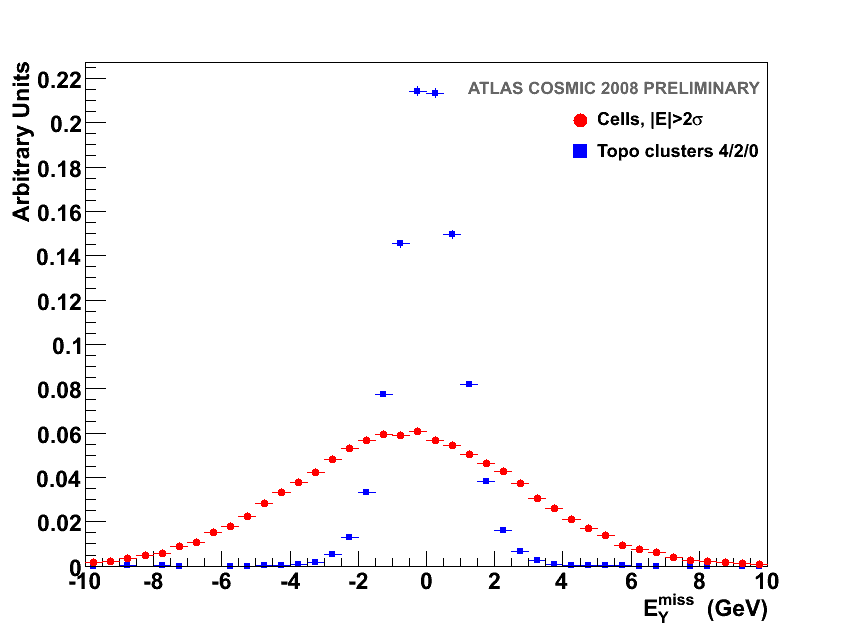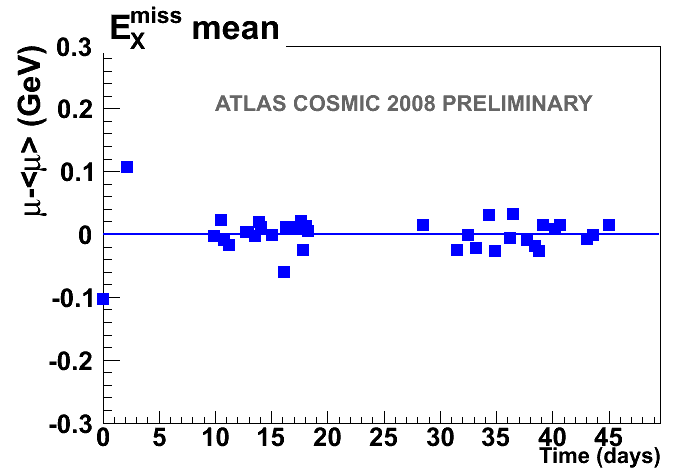
Missing ET performance on random triggers
Introduction
Contact the Jet/EtMiss combined performance coordinators (Tancredi.Carli@cernNOSPAMPLEASE.ch, Richard.Teuscher@cernNOSPAMPLEASE.ch) in case of questions and/or suggestions. The ATLAS calorimeters have recorded millions of cosmic ray and random triggered events. Detailed understanding and improvement of the signal reconstruction has made it possible to use these events to study the performance of higher level quantities such as missing ET. Data taken with close to full detector readout in September and October 2008 were reprocessed at the end of 2008. The performance of standard calorimeter missing ET algorithms, as planned to be used for the analysis of collision data, on is shown here on a sample of events collected with the random trigger. The missing vectorial and scalar transverse energies in the calorimeters are reconstructed using two methods:- The cell-based method uses all cells above a noise threshold of two standard deviations (|E|>2*
 ). This method is a simple one that characterises the basic detector performance.
). This method is a simple one that characterises the basic detector performance.
- The topocluster-based method uses topological clusters measured in the calorimeter. Clusters are derived from calorimeter cells by adding the energy in neighbouring cells with a dynamical topological cluster algorithm. All the cells in the neighbourhood of the cluster are included, if they have an energy larger than a predefined threshold (neighbour threshold). The procedure is repeated until no cells in the neighbourhood of the cluster are found. As a last step all cells surrounding the cluster are merged to the cluster. The default configuration uses a seed threshold of 4 standard deviations and a neighbour threshold of 2 standard deviations.
- EXmiss = -
 E sin
E sin cos
cos
- EYmiss = -
 E sin
E sin sin
sin
-
 ET =
ET =  E sin
E sin
- ETmiss = √((EXmiss)2+(EYmiss)2)
Missing ET variables with random triggers
Detailed analysis has been made with 50292 random events from run 91639, taken the 14th of October 2008. The cell based algorithm is a simple one that is used to assess the basic calorimeter performance. The topological clustering algorithm provides a better noise suppression and therefore a better missing ET resolution. This algorithm is close to the default missing ET reconstruction algorithm that will be used for the analysis of collision data since it provides more refined results. However it requires a more accurate description of the noise in the calorimeter. The Gaussian noise model parametrises the cell energy distribution, based on values derived from a simple Gaussian distribution. For each cell, energy values are picked by this Gaussian distribution which is centered at 0 and has a standard deviation which is equal to the respective|
Etmiss distribution of random events
Missing transverse energy distribution for random triggers (noise) Shown in red is the sum over all cell above noise and in blue the result of summing over all topological clusters (noise suppression using 4/2/0). Data are shown as markers. Overlayed is a Monte Carlo simulation where the noise is modeled as simple single Gaussian distribution Used are randomly triggered events from run 150541; taken the 23th of November 2009. no calibration is applied (em-scale). See this plot under "Public plots from collision data". |  | |
| Cell- and topocluster-based EXmiss and EYmiss distributions, showing a good control of the energy reconstruction in the 187000 cells of the Calorimeter. The topocluster-based distributions show better noise suppression than when using the cell-based method. eps version (x) eps version (y) |

|

|
|
|

|
|
| Inclusive distributions of ETmiss for both methods are shown, showing again the better noise suppression of the topocluster method. Tails in the distribution (beyond 8 GeV for topocluster-based, and 16 GeV for cell-based, variables), contributing less than 0.1% of events, have been understood to come from coherent noise in a specific region of LAr presampler. eps version |

|
|
|
The expected ETmiss distribution obtained by a randomisation of the cell energy with a Gaussian noise of width |

|
|
Stability of topocluster-based missing ET variables with time
The following plots use data taken in 35 runs between 10th September and 23rd October 2008. Run 91639 was taken on the following day (day 36). For each run, missing ET variables were computed with the standard topocluster algorithm, and fit with Gaussian distributions to extract the mean (|
Deviation of the mean of the EXmiss distribution ( Good stability is seen over the month and a half period. eps version |

|
|
Deviation of the width of the EXmiss distribution ( Good stability is seen over the month and a half period, with no significant change with time. eps version |

|
|
Deviation of the mean of the EYmiss distribution ( Good stability is seen over the month and a half period, with no significant change with time. eps version |

|
|
Deviation of the width of the EYmiss distribution ( Good stability is seen over the month and a half period, with no significant change with time. eps version |

|
|
Deviation of the mean of the Good stability is seen over the month and a half period: variations are observed, but are small compared to the width of the distribution (~1.4 GeV). eps version |

|
|
Deviation of the width of the Good stability is seen over the month and a half period, with no significant change with time. eps version |

|
Last reviewed by: Never reviewed
Topic revision: r22 - 2010-12-06 - ElmarRitsch
or Ideas, requests, problems regarding TWiki? use Discourse or Send feedback


